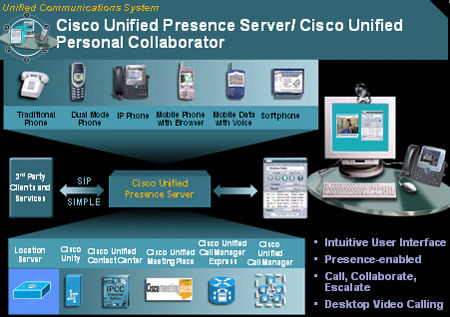Cisco at 12am March 6th will launch their new Unified Communications System (www.cisco.com/go/unified) aimed at streamlining business processes, and helping to drive productivity. Unified Communications (UC) will feature new presence, desktop tools, mobile integration and network intelligence to improve business agility and customer interaction, but just as importantly as I will indicate later, Cisco is fully embracing the SIP standard on their desktop phones. I interviewed Cisco last week and they told me that I was the first journalist or analyst to have a "first look" at this major announcement.
Cisco IP phone & the new IP Communicator softclient
Perhaps I misread the tone of the Cisco representatives during my call, but they initially seemed to downplay the significance of Cisco's embracing of SIP in favor of focusing on the entire Unified Communications platform. But in my opinion, Cisco embracing SIP is just as big news as their Unified Communications system, but more on that later.
Essentially, Cisco Systems, unveiled the Cisco Unified Communications system, which is a new suite of voice, data and video products and applications specifically designed to help organizations of all sizes to communicate more effectively. Cisco Unified Communications replaces AVVID and IP Communications. The system will allow customers to integrate their communications system with their IT infrastructure, streamlining business processes for the way effective businesses need to work today.
Based on the Cisco Service-Oriented Network Architecture (SONA) announced in December 2005, the Cisco Unified Communications system is an open and extensible platform for real-time communications based on presence, mobility and the intelligent information network. It uses the IT data network as the service delivery platform helping workers to reach the right resource the first time by delivering presence and preference information to an organization's employees.
But we're not done - Cisco is also launching a major revision of CallManager, namely CallManager 5.0, a core piece of their VoIP platform. As part of this major version release, Cisco now is supporting SIP on CallManager which in effect will enable 3rd party SIP phones to communicate with CallManager. This is a huge deal since in the past you were forced to buy Cisco phone running the Skinny protocol. Now you have a choice of IP phones. Cisco believes that their phones with tight integration with applications and strong features will continue to help them keep their market leading position.
Vicky McGovern Director of Marketing IP Communications Group said, "We believe that this changes everything. This is our new mantra, 'this changes everything' introducing Cisco's Unified Communications. And we really believe that this changes everything for three primary constituencies."
Side Note: "This changes everything" was actually a quote used by Jeff Bezos given to the Wall Street Journal after viewing a hush-hush preview for “Ginger,” an unbelievably-hyped launch for what turned out to gyroscopic scooters called the Segway. Guess Mr. Bezos should have trademarked/patented the term and then "pulled an NTP" and extorted Cisco for $612.5 million to use the phrase. :)
Vicky continued, "This changes everything first and foremost for our end-user customers. We believe this changes everything because we believe there's a key business imperative that business decision makers are not addressing in their environments today. And that is that communications is absolutely critical to business processes and communications has been looked at as a "silo application" deployed out of necessity versus being views as a key business asset. A lot of the research that Cisco has done points to the fact that there is a tremendous impact to business processes due to the lack of effective communications. Unified communications can help in generating that effectiveness and eliminating the bottlenecks and enabling businesses to grow."
Vicky explained the second constituencies will change everything for their partners due to a plethora of new partner tools. "We will work with our partners to articulate 'this changes everything' message to the key business decision maker. Cisco is well-known for being in with the technical decision maker and speaking their language. Now you're going to see us address the business decision maker with tools that will enable them to speak that language to speak to the business decision maker. We will offer sales tools, configuration tools, and pricing models and packaging models and support services that they can augment their kit bag with - so a whole new way of Cisco working with our channel partners bring this to market."
The third change is for Cisco themselves. They explained that they are repositioning their entire IP Communications (IPC) portfolio, moving it beyond IPC into the unified communications realm. Again, Cisco will be reaching out to a new audience - the business decision maker and even the voice decision maker - to help them understand how these new developments in technologies can help them solve business issues they may not even know they have. Cisco stated, "we are embarking on a new era - broadening our image from “the leader in switching & routing” to one that enables and embraces all forms of communication". 
Unified Communications System Architecture
"The Cisco Unified Communications system is the first true second-generation Internet Protocol (IP) Communications system providing not just telephone services, but rather a rich communications environment that seamlessly integrates voice, video and data collaboration in one system," said Charles Giancarlo, chief development officer, Cisco Systems, Inc.
The Cisco Unified Communications system is based on Cisco's IP Communications portfolio including Cisco CallManager, Cisco Unity, Cisco MeetingPlace and Cisco IP Contact Center and now includes additional innovative products, applications, features and capabilities. New to the Cisco Unified Communications system are Cisco Unified Personal Communicator, Cisco Unified Presence Server and Customer Interaction Analyzer. Current customers will be able to upgrade their existing systems to take advantage of the new capabilities.
"Miercom has exercised and reviewed key components of the entire Cisco Unified Communications system and after seeing it in action, we believe that Cisco has leapfrogged their competition in a number of areas," said Ed Mier, principal, Miercom. "Cisco's native implementation of SIP, which is interoperable with Skinny Call Control Protocol (SCCP) helps give customers investment protection for their system so that it can adapt as quickly as the standard does."
Barry O'Sullivan vice president and general manager of Cisco's IP Communications Business Unit told me, "Our strategy is to put as much intelligence onto the network to allow applications whether our applications or others applications to take advantage of that intelligence. So call processing intelligence, presence intelligence, and rich-media applications. Our strategy is to be open and extensible. In other words, we have embraced SIP and built in natively into our platform and we'll make these capabilities available to third party applications and phones as well as our own applications and phones".
When asked, "Any plans to federate", Barry replied, "Yes we have implemented SIP and SIMPLE into our Presence Server and we'll make that available to anyone that wants to federate with us."
Barry explained, "Building native SIP Support for Cisco Unified CallManager, Unified CallManager Express and Unified SRST we feel is a key differentiator for us. Because we built our system from the ground up to be an IP system we can do this. CallManager supports SIP natively, and SRST and CallManager Express support SIP natively in IOS - those are pieces of software that run under IOS." He continued, "Our competitors on the other hand typically have a separate system that supports SIP and proxy across to their traditional PBX." He explained that this makes it difficult for customers to manage two systems and provisioning users across two systems without feature transparency across the two systems where as the Cisco system does feature transparency.
Up to now Cisco CallManager has only been available on an "open server" running Windows. With this launch, Cisco is announcing is that they will now offer customers an appliance, based on the Linux operating system. This is another huge piece of news. CallManager on Linux? Wow! I still remember installing CallManager 1.0 many eons ago in TMC Labs. I forget now if I installed it on Windows NT 4.0 or Windows 2000. In any case, IT departments that were hesitant to run CallManager on Windows, or are Linux shops, will be excited to hear this news.
Another new product as part of this launch is Cisco Unified Personal Communicator, a software client which is a single portal into all your communications applications handling voice, video, IM, unified messaging, and collaboration. Barry, "Unified Personal Communicator gives you a single unified interface to all of these. It's your one software communications device on your desktop so you can see your voicemails, you can enter into a collaboration session, and our vision is that you will be able to drag-and-drop your presentations into Personal Communicator, drag-and-drop video to share video, etc. It will be the most visible thing at the user desktop." Cisco also mentioned they are working closely with Microsoft and will offer integration with Microsoft Office Communicator if customers wish to use that software client instead. I don't have a screenshot yet for Unified Personal Communicator but will update this post if I get one.
Cisco next explained "Cisco Customer Interaction Analyzer" for the contact center. Barry claimed, "This technology can listen to a call and using word spotting, looking at tone, inflection, and cadence to figure out the quality of the interaction and make an analysis. So it can figure out if the customer is happy or angry or was concerned about a problem and then make that analytic information available from the network to applications so you can do intelligence call routing, train your customer service representatives to be better, give that customer better service next time they call." I inquired whose technology they use and they said it is OEM'ed from eLoyalty.
Tom: So you are offering a new firmware download to enable SIP on your phones. Does this mean you are abandoning Skinny (SCCP)?
Barry: No, some of our customers will want to continue with Skinny and some of our customers will want SIP. We're going to continue to provide choice for them. But we really think the market is going to go to SIP pretty quickly and that's why we are providing full SIP functionality on our SIP phones
Tom: Is there 1-to-1 feature functionality between the new SIP firmware and the Skinny firmware? Is there anything missing?
Barry: It's over 90% is what we're saying - except for some obscure features. There is feature transparency between a SIP phone and Skinny phone, so if you are in transition with some SIP and some Skinny phones. For example you can do a shared line between a SIP phone and a Skinny phone or park a call on a SIP phone and pick it up on a Skinny phone. So we have full feature transparency. We can do this again because we support SIP natively but our competitors only support this with a bolt-on server, so it is much more difficult to have this feature transparency.
One really cool new feature is announcing is that Cisco will support dual-mode phones through partnerships with Nokia and RIM (Blackberry 7270). Good thing RIM settled with NTP or this would be a very short partnership! Cisco worked with Nokia and RIM to offer a softphone client on their dual-mode phones so you can get full-featured access to CallManager when you are within range of your wireless WiFi network.
One interesting fact Barry pointed out was, "We've seen a huge acceleration and adoption of IP communications. We're displacing 12,000 of our competitors' phones every business day. We shipped 7.5 million phones and it took us 3 years to ship the first million and just 3 months to ship the most recent million."
Tom: Was SIP a major driving force behind enabling Cisco's Unified Communications?
Barry: Yeah, it's SIP everywhere pretty much. Instead of managing voice and video and IM as separate things, what SIP lets you do is manage them all in one session. So you can seamlessly escalate IM to a voice session to a session call. The concept a call gets broadened to the concept of a session and that is much easier to manage from a software point of view.
Tom: <thinking in my head> Well, they don't call it Session Initiation Protocol (SIP) for nothing! :D Barry explained the power of SIP quite succinctly and accurately even if I already knew this.
Here is an overview/summary of the Cisco Unified Communications new products & features.
- Cisco Unified Personal Communicator simplifies the way workers share information by helping them to communicate in real time. Its user-friendly GUI (Graphical User Interface) makes it easy to move through multiple communications applications. The Unified Personal Communicator bridges the gap between the stand-alone applications on the desktop, telephone and network. Using dynamic presence information, employees can search existing directories to locate contacts and simply "click to call" using voice and video, allowing them to exchange ideas face-to-face. The virtual nature of IP networks allows remote or traveling employees to securely access these tools from wherever they are.
- The Cisco Unified Presence Server collects information about a user's status, such as whether or not they are using a device such as a telephone, personal computer or video terminal at a particular time. Using this information, applications such as Cisco Unified Personal Communicator and Cisco Unified CallManager can help users connect with colleagues more efficiently by determining the most effective method of communication. The Cisco Unified Presence Server aggregates presence information from the network as well as Cisco Unified CallManager and third-party devices using SIP and SIP for Instant Messaging and Presence Leveraging Extensions (SIMPLE) and then publishes that information to Cisco Unified IP Phones, Cisco Personal Communicator and third-party services and applications such as IBM Lotus Sametime and Microsoft Live Communications Server (LCS) 2005.
- The Customer Interaction Analyzer is being introduced to maximize effective communications with customers, a new approach to analytics in the contact center. It uses information from customer interactions, including self service and agent assisted interactions, to determine things like customer distress, agent distress, silence and word patterns. The data helps to give the conversations business context and can help a business to coach and train agents, make changes to processes and self service scripts based upon findings - ultimately creating better customer relationships and growth for the business. Additional new features of the Cisco Unified Communications System include the following:
- Cisco Unified CallManager 5.0 and Cisco Unified CallManager Express 3.4 and Survivable Remote Site Telephony (SRST) 3.4 now natively support SIP, effectively opening up the system to an emerging standards-based developer community while retaining the current security and resiliency features. A new program, SIP Verified, provides third-party verification for voice, data and video SIP endpoints. An initial set of vendors who have completed this testing is also announced.
- Cisco Unified CallManager 5.0 is now available in a choice of operating models based on customer and channel partner preference. A new appliance model version based on Linux is available now and a version based on the existing open operating system model is scheduled to be available within 12 months.
The big knock against Cisco has been their proprietary Skinny protocol, now that Cisco fully supports SIP their competitors will no longer have that ammunition. Of course, they'll probably harp on the fact that Cisco's IOS operating system is proprietary and closed. You never hear people asking Nortel or Avaya to make their PBX operating system code publicly available or "open source". In any case, it's a bright day for the VoIP industry when an industry heavyweight such as Cisco puts their full weight behind the SIP standard.













